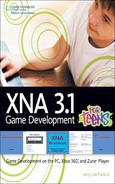0%
23Chapters
0-1Hours read
0kTotal Words
Book Description
XNA 3.0 GAME DEVELOPMENT FOR TEENS is a complete guide to entry level programming and computer game development using XNA 3.0 and the Visual C# 2008 Express programming language for beginners. This book shows readers how to create and execute computer games on their PC, and then how to port their PC games over to their Xbox 360 or Zune player. This book is for anyone looking to begin creating their own computer games with XNA 3.0 and Visual C# 2008 Express.
Table of Contents
- Copyright
- Acknowledgments
- About the Author
- Introduction
- I. XNA Development Basics
- 1. Introducing Microsoft XNA Game Studio 3.1
- 2. Getting Started
- 3. Creating Your First XNA Application
- II. Learning How to Program with Visual C# Studio Express 2008
- 4. Working with Data, Values, and Variables
- 5. Conditional Logic and Loops
- 6. Objects, Classes, and Methods
- III. Game Development Basics
- 7. Collecting User Input
- 8. Working with Images
- 9. Adding Sound Effects and Background Music
- IV. Building Games for the PC, Xbox 360, and Zune
- 10. Creating Your Own Arcade Game
- Key Features Found in Most Computer Games
- Creating the XNA Breakout Game
- Step 1—Creating a New Project
- Step 2—Defining Game World Data
- Step 3—Setting Screen Resolution and Full-Screen Mode
- Step 4—Initializing Game Play
- Step 5—Loading Game Content
- Step 6—Updating Game Play
- Step 7—Drawing the Game
- Step 8—Configuring the Screen
- Step 9—Configuring the Ball and Paddle
- Step 10—Starting Game Play
- Step 11—Processing Player Input
- Step 12—Managing Ball Movement
- Step 13—Keeping Track of the Bricks
- Step 14—Redisplaying the Bricks
- Step 15—Displaying the Splash Screen
- Summary
- 11. Porting Your Games to the Xbox 360 and Zune Player
- 10. Creating Your Own Arcade Game
- V. Appendices
- Glossary
